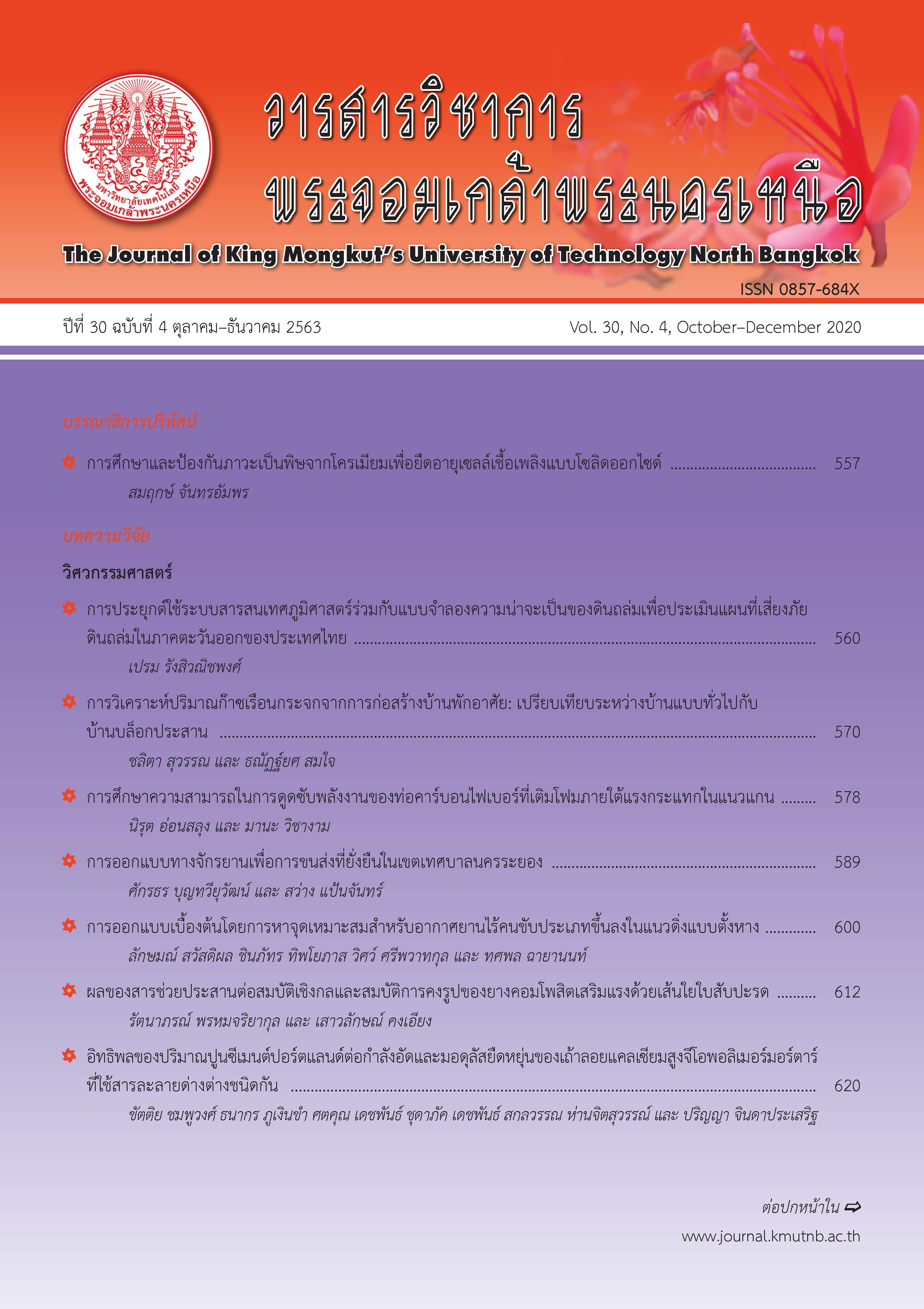การออกแบบเบื้องต้นโดยการหาจุดเหมาะสมสำหรับอากาศยานไร้คนขับประเภทขึ้นลงในแนวดิ่งแบบตั้งหาง
Main Article Content
บทคัดย่อ
อากาศยานไร้คนขับขนาดเล็กประเภทขึ้นลงในแนวดิ่งรูปแบบตั้งหาง (Tail-sitter VTOL UAV) เป็นหนึ่งในรูปแบบที่ได้รับความสนใจ และถูกนำมาศึกษาอย่างแพร่หลายในปัจจุบันเพื่อตอบสนองต่อภารกิจ และเพิ่มขีดความสามารถของอากาศยาน แต่การออกแบบอากาศยานโดยผ่านการตั้งสมมติฐาน และการประมาณน้ำหนักโดยเบื้องต้น จะต้องใช้เวลาในการออกแบบและการทดสอบที่มากขึ้น เนื่องจากต้นแบบที่ได้จากการออกแบบในแต่ละรอบจะมีความคลาดเคลื่อนไปจากความเป็นจริง ส่งผลให้ต้นแบบที่ผ่านการออกแบบมานั้นไม่ใช่ต้นแบบที่มีประสิทธิภาพ (ตัดสินโดยระยะเวลาการบิน) สูงสุดงานวิจัยนี้จึงมีวัตถุประสงค์ที่จะสร้างระเบียบวิธีการออกแบบเบื้องต้น เพื่อเพิ่มประสิทธิภาพในการออกแบบด้วยการเก็บข้อมูลชุดอุปกรณ์ที่มีอยู่ในท้องตลาดมาสร้างเป็นฐานข้อมูล และการลดระยะเวลาในการออกแบบด้วยกระบวนการหาจุดเหมาะสมในกระบวนการการเลือกชุดใบพัด ซึ่งผลจากการทดลองออกแบบอากาศยานบนเงื่อนไข 3 ชุด เพื่อออกแบบอากาศยานที่บินได้นานที่สุดสำหรับแต่ละเงื่อนไข การใช้ระเบียบวิธีการออกแบบร่วมกับกระบวนการหาจุดเหมาะสมรูปแบบ Hooke-Jeeves Pattern Search ทำให้สามารถเลือกชุดอุปกรณ์ (มอเตอร์ ใบพัด และแบตเตอรี่) ในท้องตลาดที่เหมาะสมต่อภารกิจ และสามารถลดระยะเวลาในการออกแบบลงได้เฉลี่ย 55 เปอร์เซ็นต์ เมื่อเทียบกับเวลาในการหาชุดอุปกรณ์ที่เหมาะสมจากทุกความเป็นไปได้ที่จะเกิดขึ้น
Article Details
บทความที่ลงตีพิมพ์เป็นข้อคิดเห็นของผู้เขียนเท่านั้น
ผู้เขียนจะต้องเป็นผู้รับผิดชอบต่อผลทางกฎหมายใดๆ ที่อาจเกิดขึ้นจากบทความนั้น
เอกสารอ้างอิง
[2] W. Nixon. (1998, Apr.). Improvements to tilt rotor performance through passive blade twist control. Technical Momerandum 100583, NASA. Virginia, USA. Available Source: https://ntrs.nasa.gov/archive/nasa/casi.ntrs.nasa.gov/19880013050.pdf
[3] R. Varatharajoo, E. J. Abdullah, D. L. Majid, F. I. Romli, A. S. Mohd Rafie, and K. A. Ahmad, “Design of optimum torsionally flexible proprotors for tilt-body MAVs,” Applied Mechanics and Materials and Materials, vol. 225, pp. 281–286, 2012.
[4] A. Ling, “Design and manufacturing of generic unmanned aerial vehicle fuselage assembly (payload bay, empennage, wheel assembly and wingbox) via low cost fiber glass molding process,” Thesis, Faculty of Engineering and Science, Universiti Tunku Abdul Rahman, 2012.
[5] A. Jameson. “The analysis of propeller wing flow interaction, analytic methods in aircraft aerodynamics.” in NASA Symposium Proceedings SP-228, Oct. 1969, pp. 721–749.
[6] M. Drela. (2005, Mar.). Dc Motor and Propeller Matching Lab 5 Lecture Note [Online]. Available: http://web.mit.edu/drela/Public/web/qprop/motorprop.pdf
[7] K. Deb. Optimization for Engineering Design Algorithms and Examples. New Delhi: PHI Learning Private Limited, 2012, pp. 82–104
[8] A. Essari. “Estimation of component design weights in conceptual design phase for tactical UAVs.” Doctoral dissertation, Faculty of Mechanical Engineering, University of Belgrade, 2015.

